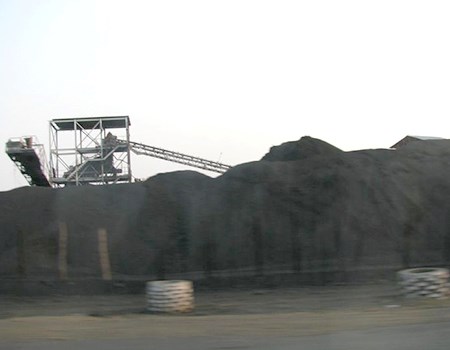Facts:
Project leader
Patrik Oskarsson, Researcher, Division of Rural Development, SLU
Project time
2018-2020
External funding
Swedish Research Council for Sustainable Development (Formas) dnr 2013-01965

The project explored the possibilities for a sustainable use of carbon through local resource management in two poor/poverty-stricken regions with major carbon assets, in the state of Jharkhand in East India and the Tete Province in northwestern Mozambique. Material collected during field work was complemented with satellite data that will show changes in detailed land use related to coal mines.
This project has examined conflicts caused by the use of coal on common lands in India and Mozambique to understand the possibilities for participatory approaches to governance to improve sustainability and equity. In both countries widespread poverty and inequalities exist, and this is particularly the case in the coal-mining regions. Yet much recent change has been enacted in support of local rights including the adoption of a new land code in Mozambique, and the implementation of Forest Rights with expansive community control in India. As Indian coal mining expands domestically, and goes abroad to Mozambique, new extractive relations are formed in the light of demands for participation.
The project builds on earlier research in central-eastern India on mineral extraction and indigenous land. Fieldwork in Jharkhand state was however a new component of the project, and Mozambique was an entirely new country for research. Extensive fieldwork was carried out at coalfields in northern Mozambique and in eastern India, and this was complemented by guest researcher visits to Edinburgh University, Scotland, the Tata Institute of Social Sciences, India and the Higher Institute of International Relations, Mozambique. The main component of data collection in the project was ethnographic fieldwork with interviews in capital regions and at the coal mines. Focus group discussions and a survey completed the fieldwork in India. To complement the situated responses with a macro picture, a GIS expert was hired on the project to analyse land use change using satellite images. The project also initialised research on air pollution which appeared as a new, shared issue for coal-side communities where both coal power and household cooking relies on coal as a fuel. One challenge that the project experienced was the unexpectedly difficult fieldwork settings in both locations due to swiftly deteriorating security situations. In India one solution was to hire a local field assistant able to carry out interviews in a safe manner. In Mozambique such a solution was not available and therefore the participatory aspect suffered.
Project results examine micro and macro conflicts related to coal in India and Mozambique, including one article about the interlinkages between the two in new global coal trade (Oskarsson and Lahiri-Dutt, 2019). The role of participation and the materiality of coal are highlighted as these relate to the governance of land and minerals. One article (Oskarsson, Lahiri-Dutt & Wennström, 2019) included GIS analysis to understand large-scale land use change over time to show the incremental ways in which smaller coal mines enable large area dispossession across an entire coalfield. A recently submitted article details the macro picture of coal use and land along the coast using imported coal (Oskarsson, Nielsen, Lahiri-Dutt & Roy, Under Review). Results across these different articles indicate the wide number of actors who simultaneously contest and benefit from coal as part of both the formal and the informal economy with varied outcomes for participatory governance. It is clear that coal has a premier status as a fuel with a long history of use. Indian coal use not only continues to expand in the traditional coalfields but also in new locations along the coast, and in new international locations including from Mozambique. Reworking the wider coal economy which provides work and other benefits for many groups, while also generating much-needed electricity, is a necessary part of dismantling coal use.
A complete list of publications is available here »
Nielsen, K. B., & Oskarsson, P. (Eds.). (2017). Industrialising Rural India: Land, Policy, Resistance. Routledge.
Nielsen, K. B., Sareen, S., & Oskarsson, P. (2020). The Politics of C aste in India’s New Land Wars. Journal of Contemporary Asia, 1–12.
Oskarsson, P. (2014). The political ecology of coal in the south Indian state of Andhra Pradesh. In K. Lahiri-Dutt (Ed.), The Coal Nation: Histories, Cultures & Ecologies (pp. 197–218). Ashgate.
Oskarsson, P. (2017). Diverging discourses on bauxite mining in eastern India: Life-supporting hills for adivasis or national treasure chests on barren lands? Society & Natural Resources, 30(8), 994–1008.
Oskarsson, P. (2017). The Nature of Bauxite Mining and Adivasi Livelihoods in the Industrialisation of Eastern India. In K. B. Nielsen & P. Oskarsson (Eds.), Industrialising Rural India: Land, Policy, Resistance (pp. 123–139). Routledge.
Oskarsson, P. (2017). Producing ‘So-So’ Infrastructure for National Energy Security at the North Karanpura Coalfields in Eastern India. South Asia: Journal of South Asian Studies, 40(4), 895–909.
Oskarsson, P. (2018). Landlock: Paralysing dispute over minerals on adivasi land in India. Australian National University E Press.
Oskarsson, P., & Bedi, H. P. (2018). Extracting environmental justice: Countering technical renditions of pollution in India’s coal industry. The Extractive Industries and Society, 5(3), 340–347.
Oskarsson, P., & Kindo, N. (2019). Coal trafficking: Reworking national energy security via coal transport at the North Karanpura Coalfields, India. In R. J. Pijpers & T. H. Eriksen (Eds.), Mining Encounters: Extractive Industries in an overheated world (pp. 121–137). Pluto Press.
Oskarsson, P., & Lahiri-Dutt, K. (2019). India’s resource (inter)nationalism: Overseas mining investments shaped by domestic conditions. The Extractive Industries and Society, 6(3), 747–755.
Oskarsson, P., Lahiri Dutt, K., & Wennström, P. (2019). From Incremental Dispossession to a Cumulative Land Grab: Understanding Territorial Transformation in India’s North Karanpura Coalfield. Development and Change, 50(6), 1485–1508.
Oskarsson, P., & Nielsen, K. B. (2014). Development deadlock: Aborted industrialization and blocked land restitution in West Bengal and Andhra Pradesh, India. Development Studies Research, 1(1), 267–278.
Oskarsson, P., & Nielsen, K. B. (2017). Industrialising Rural India. In K. B. Nielsen & P. Oskarsson (Eds.), Industrialising Rural India: Land, Policy, Resistance (pp. 3–18). Routledge.
Oskarsson, P., Nielsen, K. B., Lahiri-Dutt, K., & Roy, B. (Under review). India’s New Coal Geography. Local Environment.
Oskarsson, P., & Sareen, S. (2019). Adivasiness as C aste Expression and Land Rights Claim-Making in Central-Eastern India. Journal of Contemporary Asia, 1–17.
Sareen, S., & Oskarsson, P. (2017). Enduring Discourses and Everyday Contestation: Introduction to Special Section on Discourse and Resource C onflict in Extractive Zones of India. South Asia: Journal of South Asian Studies, 40(4), 763–771.
Patrik Oskarsson, Researcher, Division of Rural Development, SLU
2018-2020
Swedish Research Council for Sustainable Development (Formas) dnr 2013-01965

Patrik Oskarsson, Researcher, Vice Head of Division, Division of Rural Development, SLU, +4618672666